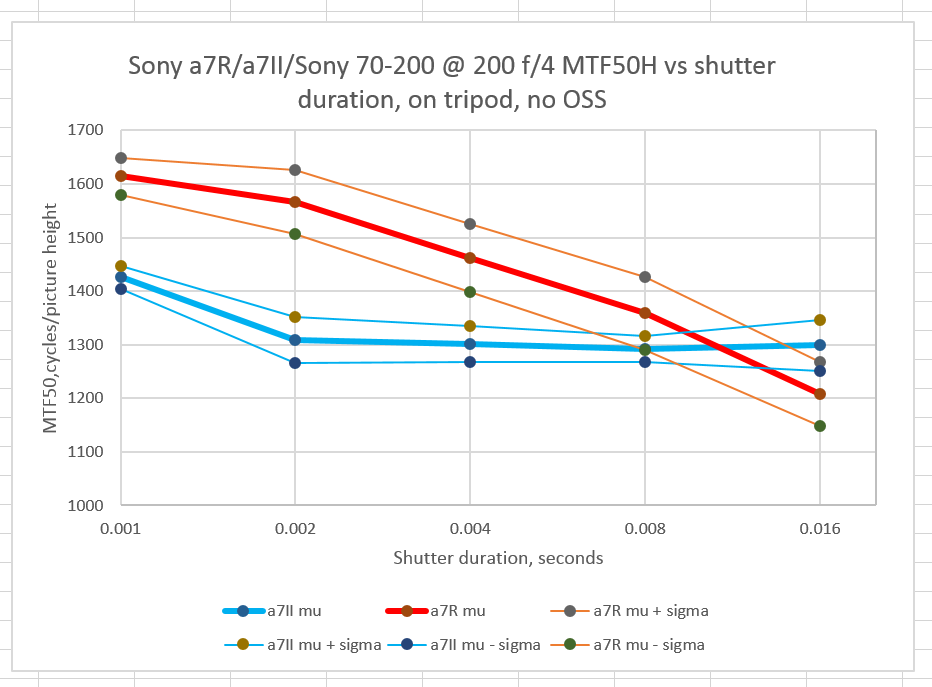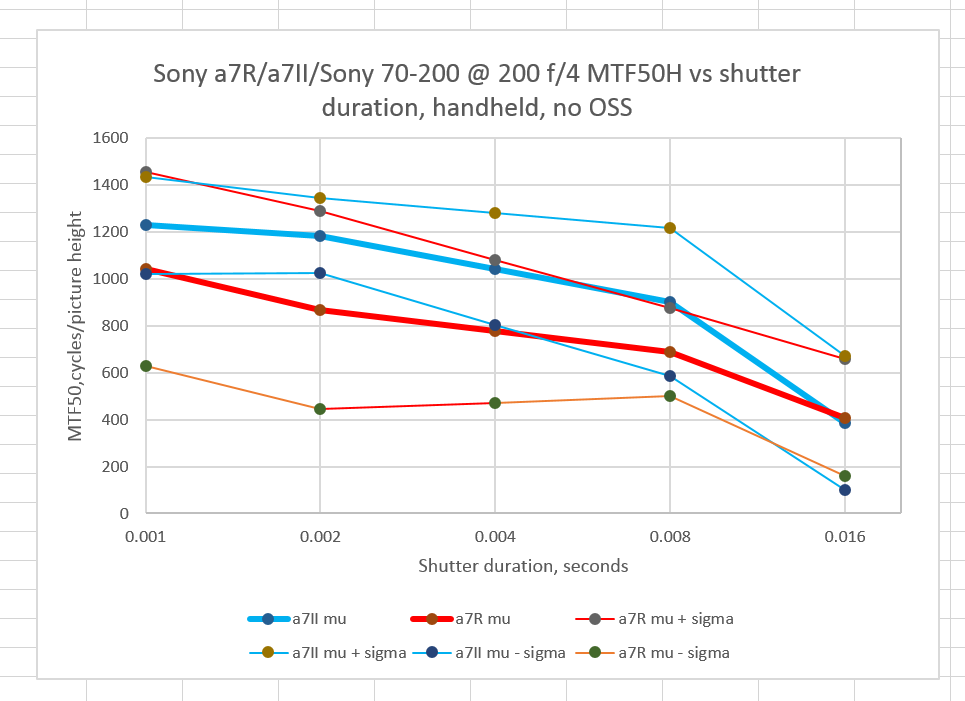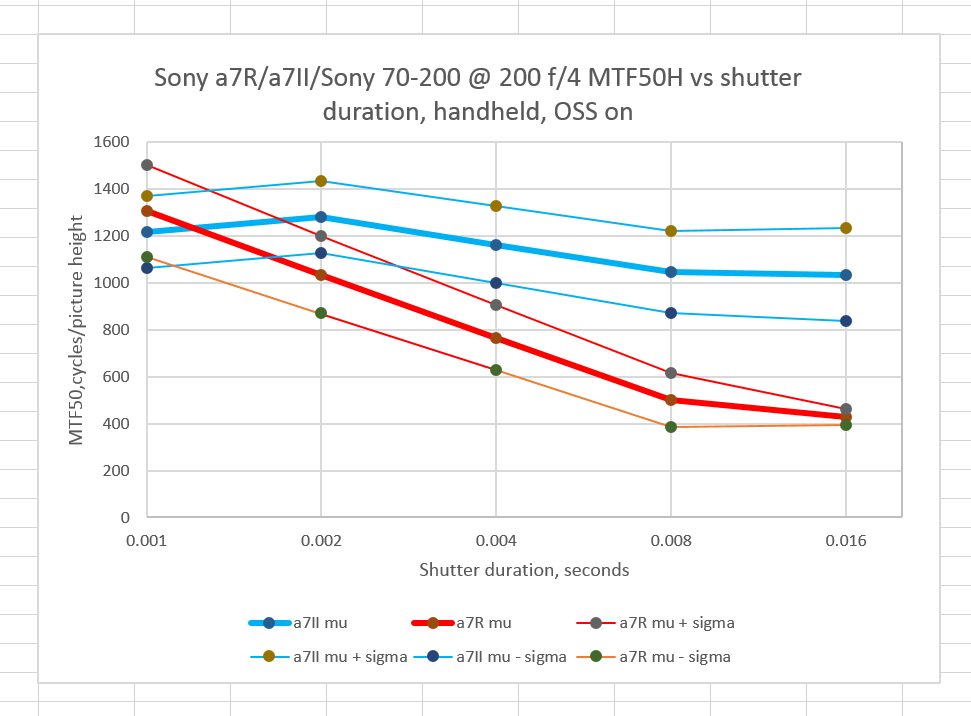Two days ago, I posted data for the Sony a7R and a7II paired with the Sony 70-200mm f/4 OSS FE lens. I did tests on a tripod and handheld, and with and without image stabilization. Slicing and dicing the data another way, we can see when the a7R shutter shock degrades sharpness to a7II levels, if MTF50 is your sharpness metric.
First, let’s look with both cameras on the heavy tripod, and no stabilization.
The bold lines are the average (aka mean, aka mu) values. The lighter lines are the average value plus and minus the standard deviations (aka sigma). If the statistics are Gaussian, about two thirds of the expected results will lie between the two pair of lighter lines.
The a7R starts out better at high shutter speeds, but as the shutter speed drops, so does sharpness. By 1/60 second exposure, the a7R is actually worse than the lower-resolution a7II. The a7II does not have nearly as much shutter-induced blur since it has electronic first-curtain shutter (EFCS), which I invoked for these tests.
Handheld, with stabilization off:
Thanks to the a7R’s shutter shock, the a7II is actually sharper at all the shutter speeds save 1/60.
Turning OSS on:
Now you’re better off with the a7II, except at 1/1000 second, where it’s tied, and 1/500 where it’s close. The parasitic interaction of the a7R shutter shock and the OSS means that you shouldn’t use OSS on the a7R except at the shutter speeds where you really don’t need it.
Using a zoom — and using it at the most unfavorable part of its range to boot — creates a situation where the extra resolution of the a7R can’t give it the advantage that it would have at high shutter speeds with a sharper lens.



Sigh….these continuing tests of the A7R discourage me. Glad I’m not doing any tele work with mine. 90 is my longest lens for mine.
I did pick up 2 Pentax manual focus f3.5 28’s recently, the M and the larger and supposedly better K. If I manage to run some tests I’ll let you know, vis a vis the 28 tests you have already done (but not with those). I have been pretty underwhelmed with the results I’ve been seeing online with the new Sony 28 f 2. Considering it has no focus scale (there oughta be a law!) it’s off my radar now.
This is an old post but I am discovering it. I have an A7R and I am not clear on y our conclusion.
From your graph, we can see that handheld, the A7R is sharper with OSS on than OSS off at all shutter speed.
However, your conclusion is that OSS should better be off at higher shutter speed.
Why is that exactly?
Interesting results, I recently obtained low-use A7r and noticed with SONY OSS lenses such as the 24-70mm f/4 Zeiss/Sony FE and the 28-70mm kit lens with OSS on handheld shots at speeds between 1/125 and 1/250 images are noticeably softer than my 21mp Panasonic GX8 with the 12-35mm OIS F2.8 lens and even my 14mp Panasonic LX100 with the Leica Sumilux 24-70mm (equivalent) f/1.7 lens.
Except for some Sony G-master lenses I’ve tried, it seems the Sony/Zeiss zooms are often mediocre at far a sharpness, on a par with many older vintage primes and not quite as good as a Tamaron 28-75mm f/2.8 LD I paid $100 for.
lens sharpness aside, shutter shock on the A7r seems to surface at random but most often noticeable around 1/160th with Sony lenses and light primes. And not so much with tele lenses for some reason. Installing the battery grip or using a tripod seems to reduce or eliminate the shutter-induced blur.
With my A7r , I noticed the lens mount screws had loosened slightly and tightening them seemed to help greatly but there is still some slight lens mount wobble that seems to be due to the two-piece metal/plastic mount design common to early A7 and A7r cameras, and with the lenses I ‘ve noticed the most shutter blur with I seem to feel more shutter shock imparted to the lens, such as with the lighter plastic sony lenses and lightweight pancake primes and I suspect the blurriness may be due in part to some shock imparted to lenses rather than the sensor as tightening the mount screws also seemed to help on lenses that showed the most shutter-induced blur.
I have ordered a quality, all-metal single-piece lens mount replacement to see if that helps and can advise if anyone is interested.